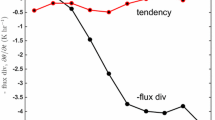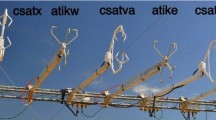Abstract
Sonic anemometers are capable of measuring the wind speed in all three dimensions at high frequencies (10–50 Hz), and are relied upon to estimate eddy-covariance-based fluxes of mass and energy over a wide variety of surfaces and ecosystems. In this study, wind-velocity measurement errors from a three-dimensional sonic anemometer with a non-orthogonal transducer orientation were estimated for over 100 combinations of angle-of-attack and wind direction using a novel technique to measure the true angle-of-attack and wind speed within the turbulent atmospheric surface layer. Corrections to the vertical wind speed varied from −5 to 37% for all angles-of-attack and wind directions examined. When applied to eddy-covariance data from three NOAA flux sites, the wind-velocity corrections increased the magnitude of CO2 fluxes, sensible heat fluxes, and latent heat fluxes by ≈11%, with the actual magnitude of flux corrections dependent upon sonic anemometer, surface type, and scalar. A sonic anemometer that uses vertically aligned transducers to measure the vertical wind speed was also tested at four angles-of-attack, and corrections to the vertical wind speed measured using this anemometer were within ±1% of zero. Sensible heat fluxes over a forest canopy measured using this anemometer were 15% greater than sensible heat fluxes measured using a sonic anemometer with a non-orthogonal transducer orientation. These results indicate that sensors with a non-orthogonal transducer orientation, which includes the majority of the research-grade three-dimensional sonic anemometers currently in use, should be redesigned to minimize sine errors by measuring the vertical wind speed using one pair of vertically aligned transducers.
Similar content being viewed by others
References
Baldocchi D, Falge E, Gu LH, Olson R, Hollinger D, Running S, Anthoni P, Bernhofer C, Davis K, Evans R, Fuentes J, Goldstein A, Katul G, Law B, Lee XH, Malhi Y, Meyers T, Munger W, Oechel W, Paw U KT, Pilegaard K, Schmid HP, Valentini R, Verma S, Vesala T, Wilson K, Wofsy S (2001) Fluxnet: a new tool to study the temporal and spatial variability of ecosystem-scale carbon dioxide, water vapor, and energy flux densities. Bull Am Meteorol Soc 182(11): 2415–2434
Blonquist JM Jr, Tanner BD, Bugbee B (2009) Evaluation of measurement accuracy and comparison of two new and three traditional net radiometers. Agric For Meteorol 149(10): 1709–1721
Bristow KL, Kluitenberg GJ, Horton R (1994) Measurement of soil thermal properties with a dual-probe heat-pulse technique. Soil Sci Soc Am J 58(5): 1288–1294
Christen A, Gorsel Ev, Andretta M, Calanca P, Rotach MW, Vogt R (2000) Intercomparison of ultrasonic anemometers during the map Riviera project. Paper presented at ninth conference mountain meteorology, Snowmass Village, CO, August, 2000
Frank J, Massman WJ (2011) Discrepancies in measured sensible heat flux from two different sonic anemometers. Paper presented at 2011 AmeriFlux science meeting & 3rd NACP all-investigators meeting, New Orleans, LA, January, 2011
Gash JHC, Dolman AJ (2003) Sonic anemometer (Co)sine response and flux measurement I. The potential for (co)sine error to affect sonic anemometer-based flux measurements. Agric For Meteorol 119(3–4): 195–207
Gilmanov TG, Aires L, Barcza Z, Baron VS, Belelli L, Beringer J, Billesbach D, Bonal D, Bradford J, Ceschia E, Cook D, Corradi C, Frank A, Gianelle D, Gimeno C, Gruenwald T, Guo HQ, Hanan N, Haszpra L, Heilman J, Jacobs A, Jones MB, Johnson DA, Kiely G, Li SG, Magliulo V, Moors E, Nagy Z, Nasyrov M, Owensby C, Pinter K, Pio C, Reichstein M, Sanz MJ, Scott R, Soussana JF, Stoy PC, Svejcar T, Tuba Z, Zhou GS (2010) Productivity, respiration, and light-response parameters of world grassland and agroecosystems derived from flux-tower measurements. Rangel Ecol Manag 63(1): 16–39
Hicks BB (1972) Propeller anemometers as sensors of atmospheric turbulence. Boundary-Layer Meteorol 3(2): 214–228
Kaimal JC, Gaynor JE, Zimmerman HA, Zimmerman GA (1990) Minimizing flow distortion errors in a sonic anemometer. Boundary-Layer Meteorol 53(1): 103–115
Loescher HW, Ocheltree T, Tanner B, Swiatek E, Dano B, Wong J, Zimmerman G, Campbell J, Stock C, Jacobsen L, Shiga Y, Kollas J, Liburdy J, Law BE (2005) Comparison of temperature and wind statistics in contrasting environments among different sonic anemometer-thermometers. Agric For Meteorol 133(1–4): 119–139
Massman WJ, Lee X (2002) Eddy covariance flux corrections and uncertainties in long-term studies of carbon and energy exchanges. Agric For Meteorol 113(1–4): 121–144
Mauder M, Oncley SP, Vogt R, Weidinger T, Ribeiro L, Bernhofer C, Foken T, Kohsiek W, De Bruin HAR, Liu H (2007) The energy balance experiment EBEX-2000. Part II: Intercomparison of eddy-covariance sensors and post-field data processing methods. Boundary-Layer Meteorol 123(1): 29–54
Meyers TP (2001) A comparison of summertime water and CO2 fluxes over rangeland for well watered and drought conditions. Agric For Meteorol 106(3): 205–214
Meyers TP, Heuer M (2006) A field methodology to evaluate sonic anemometer angle-of-attack errors. Paper presented at 27th conference on agricultural and forest meteorology, San Diego, CA, May, 2006
Meyers TP, Hollinger SE (2004) An assessment of storage terms in the surface energy balance of maize and soybean. Agric For Meteorol 125(1–2): 105–115
Motha RP, Verma SB, Rosenberg NJ (1980) Flux-angle distribution of momentum and sensible heat over a vegetated surface. Agric Meteorol 22(2): 121–127
Nakai T, van der Molen MK, Gash JHC, Kodama Y (2006) Correction of sonic anemometer angle-of-attack errors. Agric For Meteorol 136(1–2): 19–30
Ochsner TE, Sauer TJ, Horton R (2007) Soil heat storage measurements in energy balance studies. Agron J 99(1): 311–319
Schotanus P, Nieuwstadt FTM, Bruin HAR (1983) Temperature measurement with a sonic anemometer and its application to heat and moisture fluxes. Boundary-Layer Meteorol 26(1): 81–93
van der Molen MK, Gash JHC, Elbers JA (2004) Sonic anemometer (co)sine response and flux measurement—II. The effect of introducing an angle-of-attack dependent calibration. Agric For Meteorol 122(1–2): 95–109
Webb EK, Pearman GI, Leuning R (1980) Correction of flux measurements for density effects due to heat and water-vapor transfer. Q J R Meteorol Soc 106(447): 85–100
Weiss A, Allen LH (1976) Flux-angle distribution of momentum as determined from propeller anemometer measurements. Q J R Meteorol Soc 102(434): 775–779
Wilson TB, Meyers TP (2007) Determining vegetation indices from solar and photosynthetically active radiation fluxes. Agric For Meteorol 144(3–4): 160–179
Wilson K, Goldstein A, Falge E, Aubinet M, Baldocchi D, Berbigier P, Bernhofer C, Ceulemans R, Dolman H, Field C, Grelle A, Ibrom A, Law BE, Kowalski A, Meyers T, Moncrieff J, Monson R, Oechel W, Tenhunen J, Valentini R, Verma S (2002a) Energy balance closure at fluxnet sites. Agric For Meteorol 113(1–4): 223–243
Wilson KB, Baldocchi DD, Aubinet M, Berbigier P, Bernhofer C, Dolman H, Falge E, Field C, Goldstein A, Granier A, Grelle A, Halldor T, Hollinger D, Katul G, Law BE, Lindroth A, Meyers T, Moncrieff J, Monson R, Oechel W, Tenhunen J, Valentini R, Verma S, Vesala T, Wofsy S (2002b) Energy partitioning between latent and sensible heat flux during the warm season at fluxnet sites. Water Resour Res 38(12): 1294
Author information
Authors and Affiliations
Corresponding author
Rights and permissions
About this article
Cite this article
Kochendorfer, J., Meyers, T.P., Frank, J. et al. How Well Can We Measure the Vertical Wind Speed? Implications for Fluxes of Energy and Mass. Boundary-Layer Meteorol 145, 383–398 (2012). https://doi.org/10.1007/s10546-012-9738-1
Received:
Accepted:
Published:
Issue Date:
DOI: https://doi.org/10.1007/s10546-012-9738-1




